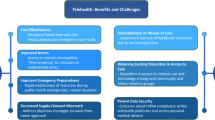Abstract
The means of designing an effective user interface software package varies from one application to another. Almost the entire ICT infrastructure was damaged following the impact of the tsunami tidal wave. Under such circumstances, transporting critically ill patients is a must and becomes the first priority. Many considerations are needed when designing a specific user interface for emergency situations in developing countries. In this study we proposed how to design the user interface in order to support emergency medical care in the early stages of disasters. The user interface was classified into two tabs, firstly to indicate critically ill patients and secondly to notify details of the medicine having been administered to the patients. Classifying the user interface of emergency medical care information systems by using VHF radio connections will be beneficial, especially for the early stages of disaster-stricken developing countries, in order to preserve the lives of more victims.










Similar content being viewed by others
Reference
Lowrey, W., Evans, W., Gower, K. K., Robinsan, J. A., et al., Effective media communication of disasters: Pressing problems and recommendations. BMC Public Health. 7:97, 2007.
Doocy, S., Rofi, A., Moodie, C., Spring, E., Bradly, S., Burnham, G., and Robinson, C., Tsunami mortality in Aceh province Indonesia. Bull. World Health Organ. 85:273–278, 2007. doi:10.2471/BLT.06.033308.
Mori, G., Paterno, F., and Santoro, C., Design and development of multidevice user interfaces through multiple logical description. IEEE Trans. Softw. Eng. 30(8):507–520, 2004. doi:10.1109/TSE.2004.40.
Guerrero, J., Vanderdonckt, J., Gonzalez, J. M., and Winckler, M., Modelling user interface to workflow information systems. IEEE Computer Society. 55–60, 2008.
Chu, Y., and Ganz, A., A mobile teletrauma system using 3G networks. IEEE Trans. Inf. Technol. Biomed. 8(4):456–463, 2004. doi:10.1109/TITB.2004.837893.
Lin, Y. H., Jan, I. C., Chow-In Ko, P., Chen, Y., Wong, J. M., and Jan, G. J., A wireless PDA based physiological monitoring system for patient transport. IEEE Trans. Inf. Technol. Biomed. 8(4):439–448, 2004. doi:10.1109/TITB.2004.837829.
Handerson, S. O., Calder, K., Lance, B., Greenspan, J., and Swadron, S. P., Emergency Medicine. Landes Bioscience, Georgetown, Texas, USA. p: 3–4, 2006.
Ulmer, R. R., Seeger, M. W., and Sellnow, T. L., Post crisis communication and renewal: Expanding the parameters of post crisis discourse. Public Relat. Rev. 33(2):130–134, 2007. doi:10.1016/j.pubrev.2006.11.015.
Ghobarah, A., Saarcioglu, M., and Nistor, I., The impact of the 26 December 2004 earthquake and tsunami on structures and infrastructure. Eng. Structures. 28:312–326, 2006. doi:10.1016/j.engstruct.2005.09.028.
Choi, E. C. H., Taib, R., Shi, Y., and Chen, F., Multimodal user interface for traffic incedent management in control room. IET Intell. Transp. Syst. 1(1):27–36, 2007. doi:10.1049/iet-its:20060038.
Takahashi, A., Ishii, N., Kawashima, T., and Nakao, H., Assessment of medical response capacity in the time of disaster: the estimated formula of hospital treatment capacity (HTC), the maximum receivable number of patients in hospital. Kobe J. Med. Sci. 53(5):189–198, 2007.
Acknowledgement
This research was granted by Asia Pacific Tele-Community (APT), HRD Program for Exchange of ICT Researchers and Engineers, Ministry of Internal Affairs and Communications Japan. We would also like to thank Prof. Cissy RS Prawira as President Director Hasan Sadikin General Hospital/University of Padjadjaran School of Medicine Bandung Indonesia and Director Garut Hospital for supporting database during research.
Author information
Authors and Affiliations
Corresponding author
Rights and permissions
About this article
Cite this article
Sutiono, A.B., Qiantori, A., Prasetio, S. et al. Designing an Emergency Medical Information System for the Early Stages of Disasters in Developing Countries: The Human Interface Advantage, Simplicity and Efficiency. J Med Syst 34, 667–675 (2010). https://doi.org/10.1007/s10916-009-9280-y
Received:
Accepted:
Published:
Issue Date:
DOI: https://doi.org/10.1007/s10916-009-9280-y




